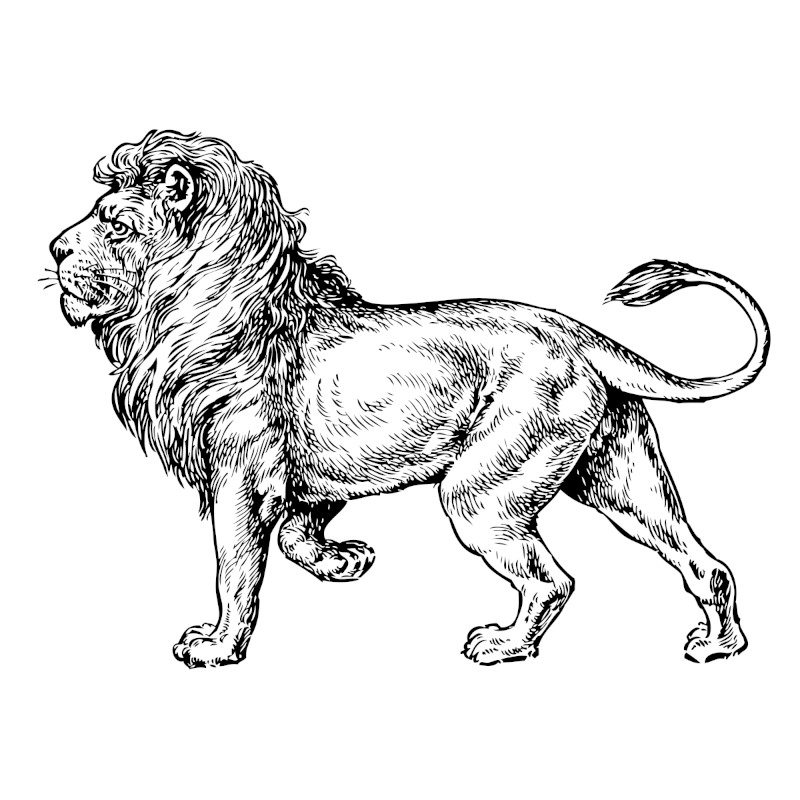Lions are popular choices for animal drawings, and within this article we give tips and techniques on how to easily draw a quick lion drawing.
Introduction to Lion Drawings
Lions have always been a much loved animal, despite not being native to many parts of the world. Their connection to our domesticated cats have enabled us to better understand this creature, as well as through their inclusion in zoos and safari parks. Lions have also featured regularly in children's stories and cartoons, with their dangerous nature disguised for a more friendly demeanor.
There are several elements to a lion which make it particularly interesting from an artistic point of view, such as its physical strength, as well as its mane, and these elements are often what artists will focus on. Our selection of artworks below can inspire you to draw your own versions, with many different styles and compositions included, helping beginners and more advanced sketchers alike.
List of Lion Drawings and Paintings
We have listed a number of famous lion paintings and drawings below, and where the artist is known, we have included a summary of their work alongside each image. There is a mixture of artistic periods and styles, as well as compositions, angles and postures to help give you as much inspiration as possible. We have also covered other creatures elsewhere, such as birds, butterflies and fish.
The images provided below are courtesy of rawpixel, as copyright-free, public domain content. Feel free to use them for inspiration, trying out different ways of constructing your lions, be it as simple pencil sketches or more elaborate paintings in oils, acrylics or watercolors. There is a wealth of art to enjoy, with photography also regularly featuring these powerful, stunning creatures.
Vintage lion, Wild Animal
This vintage illustration of a lion in side profile will help you to understand the muscular balance of this beautiful creature, with lines varying in intensity in order to create shadows and depth. The tail curls over, and one paw is lifted into the air as we imagine the lion wandering slowly to our left. Its focus is firmly on something lying off to the left hand side, and it holds a serious expression on its face. The detail across the mane is also highly impressive within this artwork and it may inspire you to produce your own lion art.
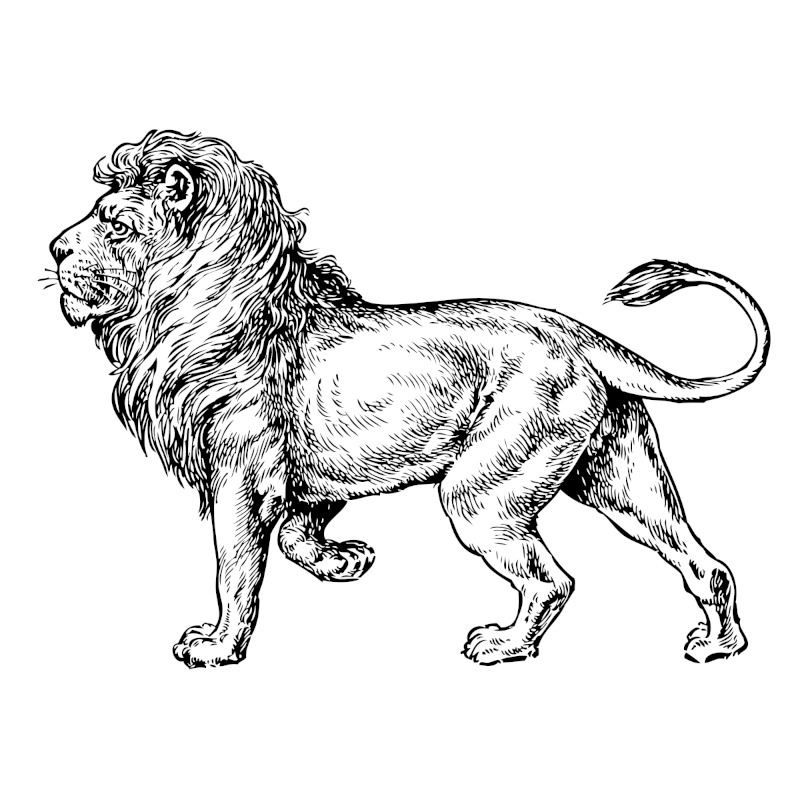 Vintage lion, Wild Animal (image provides by rawpixel as public domain, copyright-free)
Vintage lion, Wild Animal (image provides by rawpixel as public domain, copyright-free)
Vintage Lion Illustration by Albert Edelfelt
This carefully crafted sketch by a famous Finnish artist indicates how lions were drawn in previous centuries. The animal's torso and legs are noticeably skinnier that we might see today, and there is none of the strength and confidence that we normally associate with lions. It may simply have been that the artist was viewed an elderly lion at the time, and wanted to be as accurate to reality as possible.
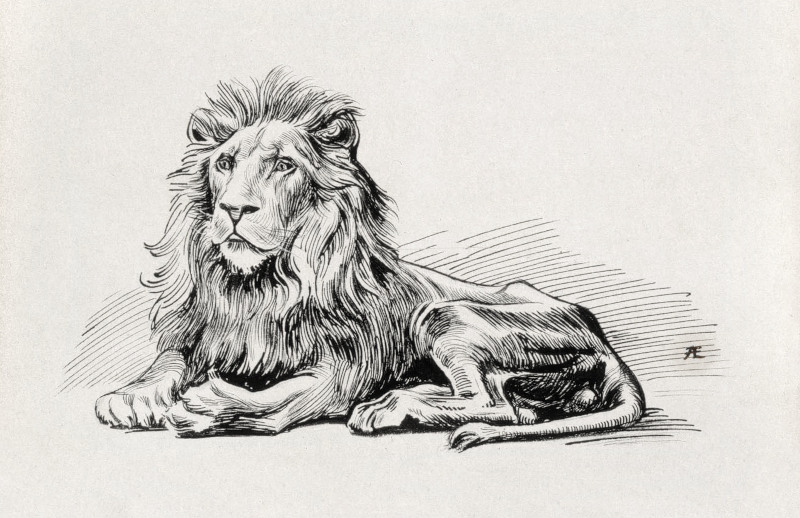 Vintage Lion Illustration by Albert Edelfelt (image provides by rawpixel as public domain, copyright-free)
Vintage Lion Illustration by Albert Edelfelt (image provides by rawpixel as public domain, copyright-free)
Lions drawing, vintage animal illustration
This illustration features two lions together, with a symbolic pose from the male who stands in a confident and protective pose. They appear to be on a rock face, with the artist including a little background detail to set the scene of this work. The lines are relatively loose, suggesting that the artist worked quickly, and may already have been very familiar with sketching animals such as this.
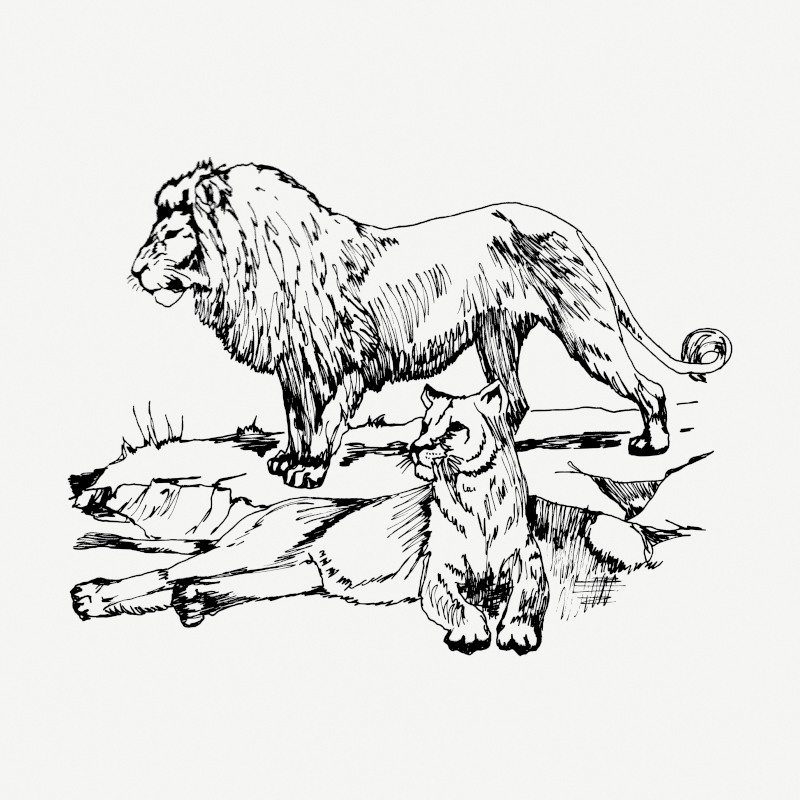 Lions drawing, vintage animal illustration (image provides by rawpixel as public domain, copyright-free)
Lions drawing, vintage animal illustration (image provides by rawpixel as public domain, copyright-free)
Henri Rousseau's The Sleeping Gypsy
Henri Rousseau is famous for his primitive depictions of jungles, much of which was entirely from his own imagination. We do know that he studied wild animals within French zoos and managed to create a unique style that bordered on cartoonish. Whilst some academics rejected this approach, many others found it charming and unhindered by formulaic teaching, and his work proved popular with the public. The Sleeping Gypsy, found below, remains one of his most famous paintings of all.
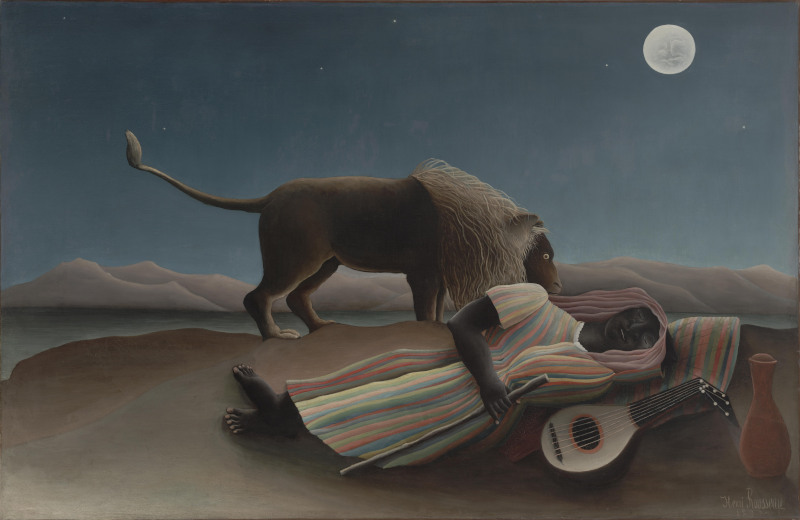 Henri Rousseau's The Sleeping Gypsy (image provides by rawpixel as public domain, copyright-free)
Henri Rousseau's The Sleeping Gypsy (image provides by rawpixel as public domain, copyright-free)
The Repast of the Lion by Henri Rousseau
Here we find another lion from the famous French animal painter, Henri Rousseau. He covered many different exotic creatures within his jungle scenes. His oeuvre did take on other themes and content, but it is this body of work that remains the best known of all. He would give many of his animals a personality by creating a human side to their faces, and this proved to be a key to his success.
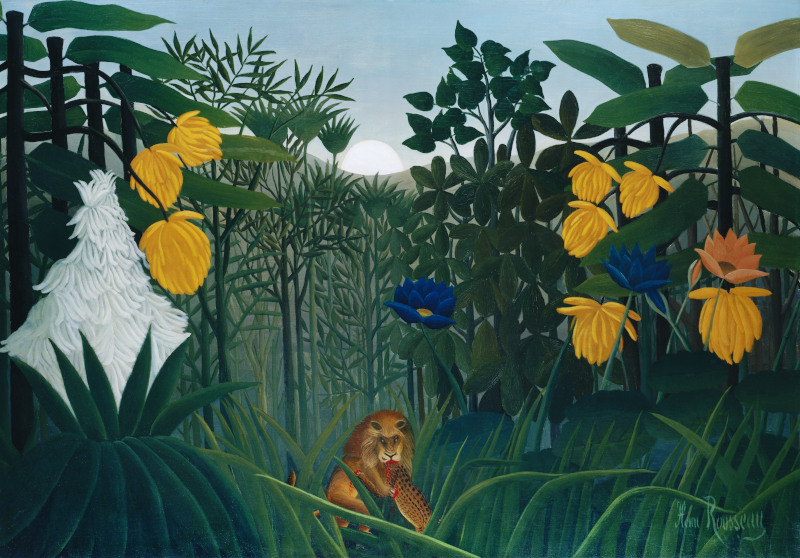 The Repast of the Lion by Henri Rousseau (image provides by rawpixel as public domain, copyright-free)
The Repast of the Lion by Henri Rousseau (image provides by rawpixel as public domain, copyright-free)
Henri Rousseau's The Hungry Lion Throws Itself on the Antelope
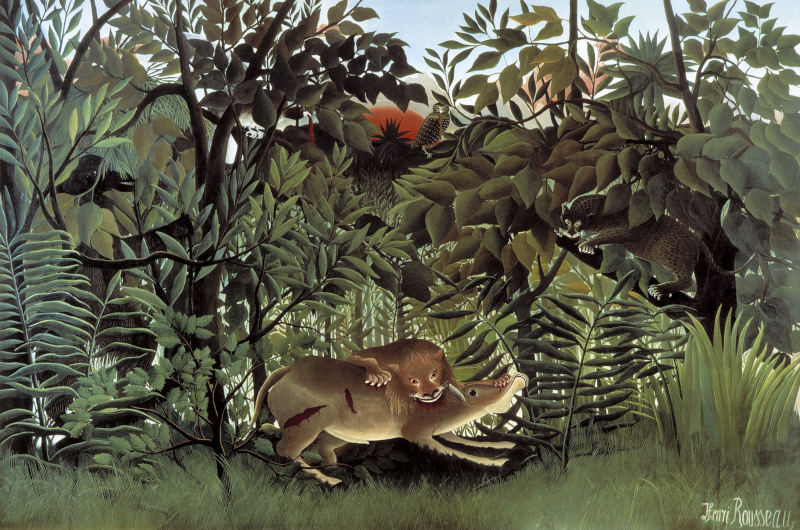 Henri Rousseau's The Hungry Lion Throws Itself on the Antelope (image provides by rawpixel as public domain, copyright-free)
Henri Rousseau's The Hungry Lion Throws Itself on the Antelope (image provides by rawpixel as public domain, copyright-free)
Daniel in the Lions' Den by Peter Paul Rubens
This highly polished artwork by Peter Paul Rubens features a whole plethora of lions in a variety of poses, as Daniel looks on in despair. Symbolically, he looks to the sky for support and stares upwards through a hole in the cave. There appears to be no escape for him in this composition which is inspired by religious scripture, on which Rubens relied in a number of his paintings. The darkness above the lions adds to the fear and danger, as more animals maybe lurking in the darkness.
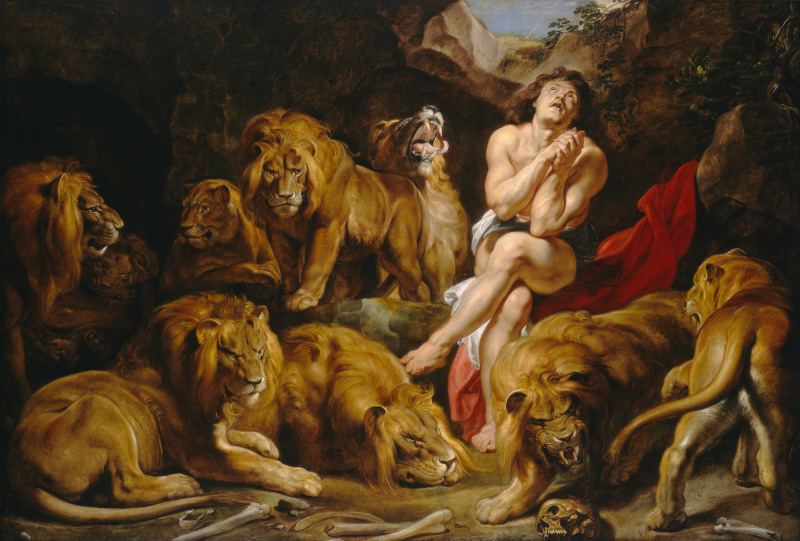 Daniel in the Lions' Den by Peter Paul Rubens (image provides by rawpixel as public domain, copyright-free)
Daniel in the Lions' Den by Peter Paul Rubens (image provides by rawpixel as public domain, copyright-free)
Head of a Lion with Prominent Mane Illustration
This bold illustration places the head of a lion firmly in our focus. This is an excellent introduction in how to draw a lion head, with a prominent mane surrounding his main facial features. One could easily trace this vintage piece to create a quick lion's head, and potentially some might even take up the challenge of drawing the rest of the body too, from their own imagination.
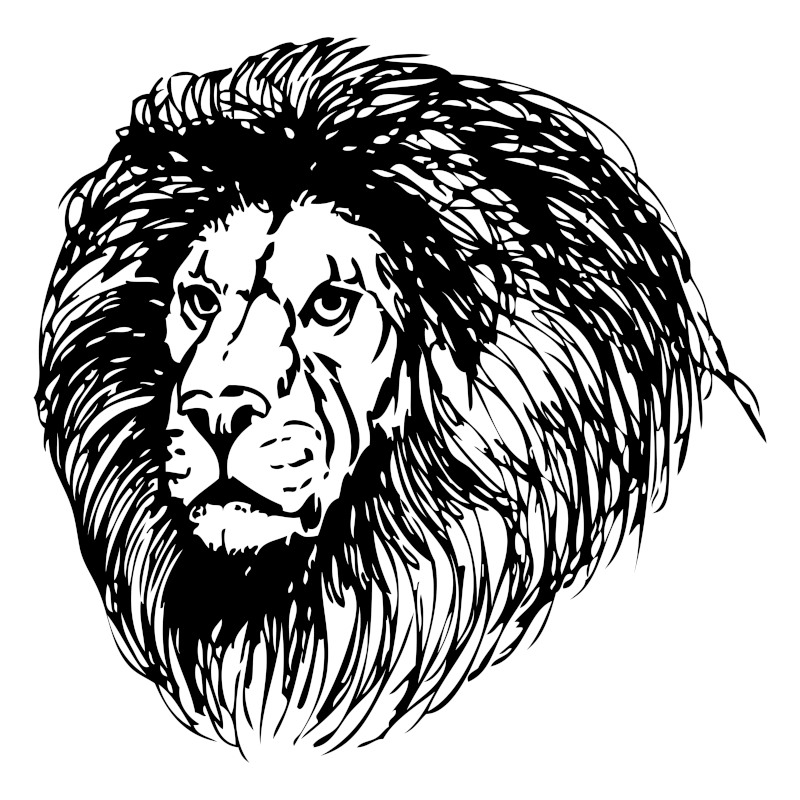 Head of a Lion with Prominent Mane Illustration (image provides by rawpixel as public domain, copyright-free)
Head of a Lion with Prominent Mane Illustration (image provides by rawpixel as public domain, copyright-free)
Reclining lion by Marcus de Bye (17th Century Print)
.jpg) Reclining lion by Marcus de Bye (17th Century Print) (image provides by rawpixel as public domain, copyright-free)
Reclining lion by Marcus de Bye (17th Century Print) (image provides by rawpixel as public domain, copyright-free)
19th Century, Charcoal on Paper Drawing Study of a Lion
Individual charcoal strokes can be seen in this drawing of a tired lion relaxing on the ground. Areas are left blank to provide a contrast which brings depth against the darker lines, and there is also a variation in the strength of lines, with some softer than others which provides an interesting variation across the piece. The sleeping or relaxing lion is a common pose for artists, and also a look that we often come across when visiting lions in the wild, such as the high temperatures found in such regions for most of the year.
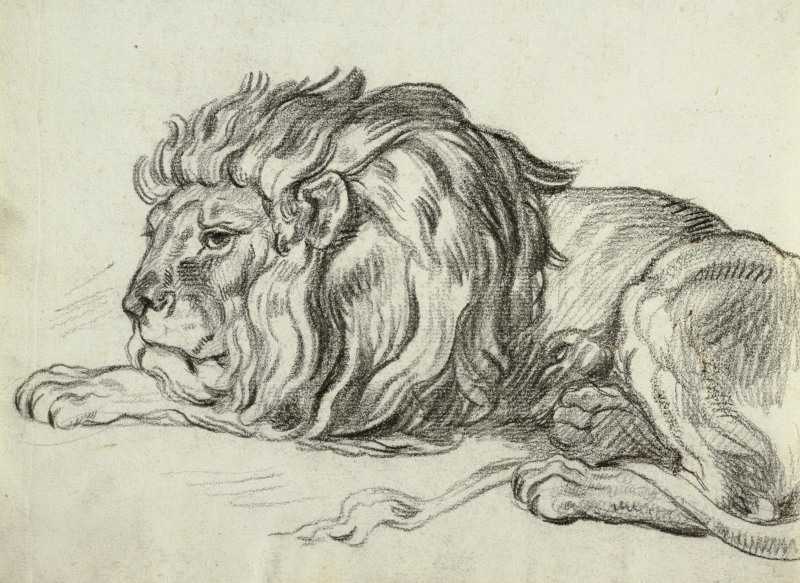 19th Century, Charcoal on Paper Drawing Study of a Lion (image provides by rawpixel as public domain, copyright-free)
19th Century, Charcoal on Paper Drawing Study of a Lion (image provides by rawpixel as public domain, copyright-free)
Dutch 18th Century Lion, facing right, with right forepaw on globe by Isaac Taylor
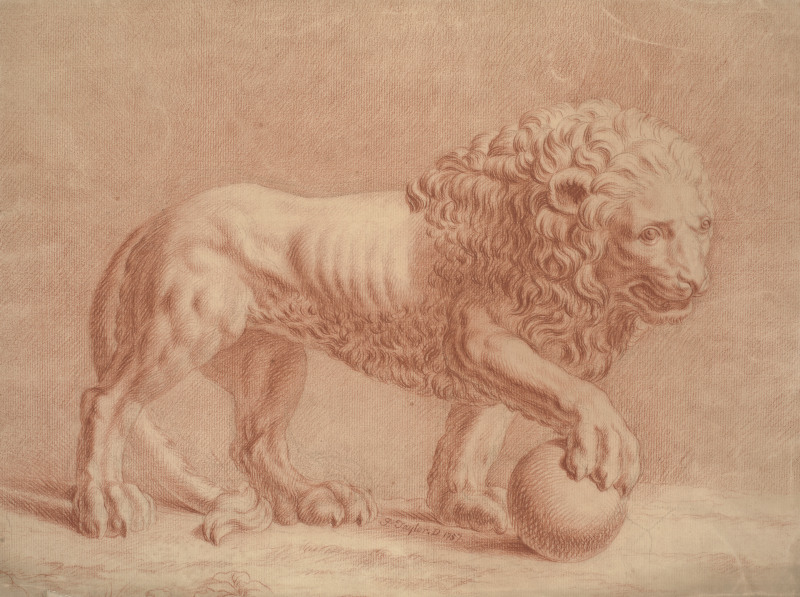 Dutch 18th Century Lion, facing right, with right forepaw on globe by Isaac Taylor (image provides by rawpixel as public domain, copyright-free)
Dutch 18th Century Lion, facing right, with right forepaw on globe by Isaac Taylor (image provides by rawpixel as public domain, copyright-free)
Leonardo da Vinci's Saint Jerome in the Wilderness
The lion included here is believed to have been friendly to Saint Jerome, providing him company at a time of great challenge. Leonardo and Michelangelo both made sketches of lions in their careers, and seemed curious about this particular animal. Both were masters at drawing, and practiced for hours at a time in order to improve their technical skills. Both also understood the importance of observation too. Whilst they would never have seen a lion in person, they were still able to use a variety of resources in the Renaissance era to produce fairly believable depictions of this great creature. Many of the developments made by Renaissance masters such as this was taken into the Baroque era, and onwards from them, with key names such as these still highly celebrated today.
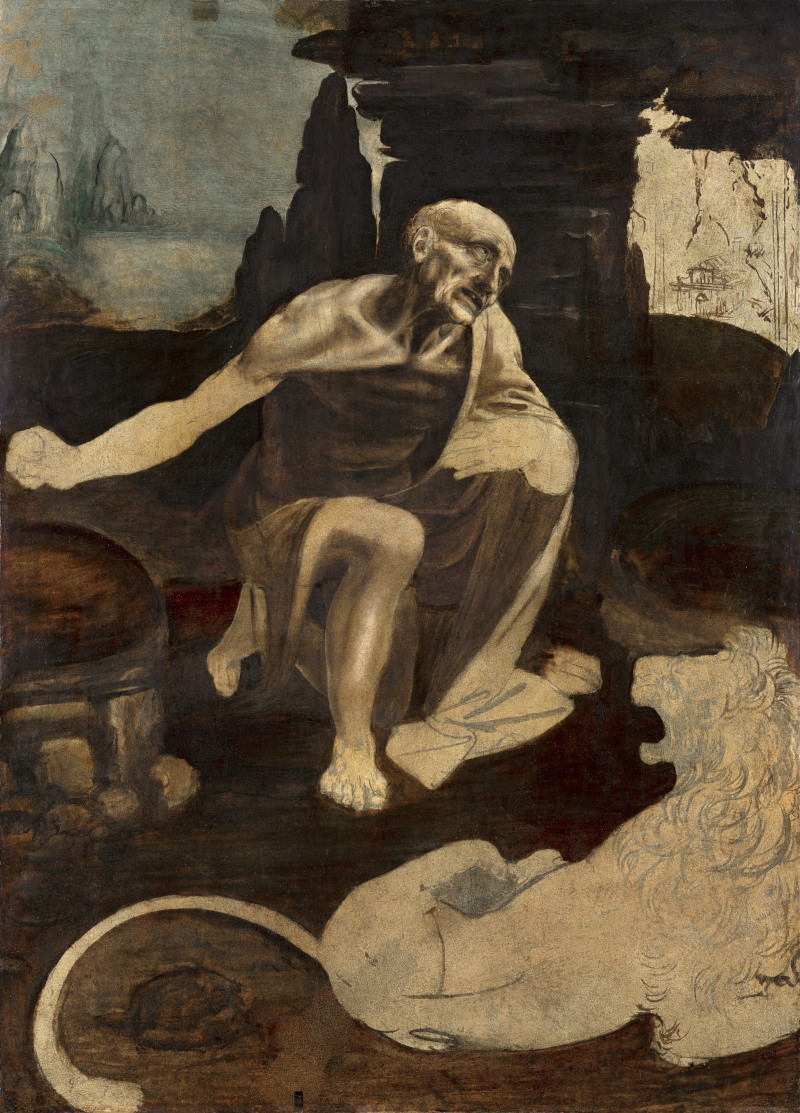 Leonardo da Vinci's Saint Jerome in the Wilderness (image provides by rawpixel as public domain, copyright-free)
Leonardo da Vinci's Saint Jerome in the Wilderness (image provides by rawpixel as public domain, copyright-free)
Lion Devouring a Goat after Eugene Delacroix
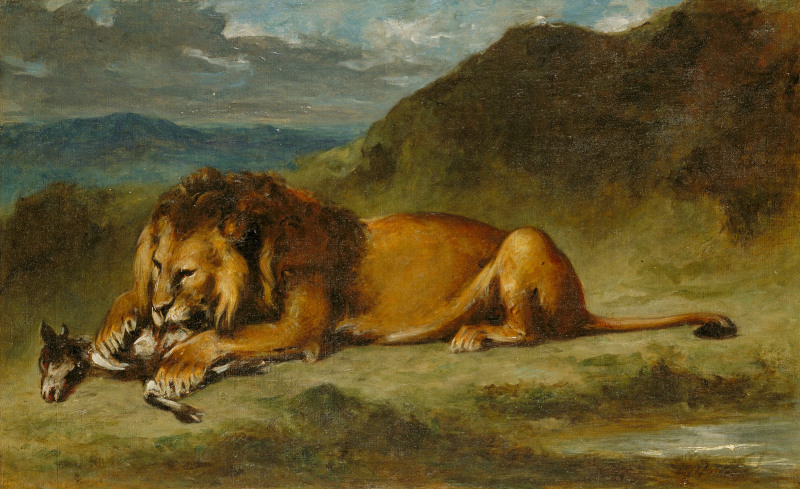 Lion Devouring a Goat after Eugene Delacroix (image provides by rawpixel as public domain, copyright-free)
Lion Devouring a Goat after Eugene Delacroix (image provides by rawpixel as public domain, copyright-free)
French Playing Cards
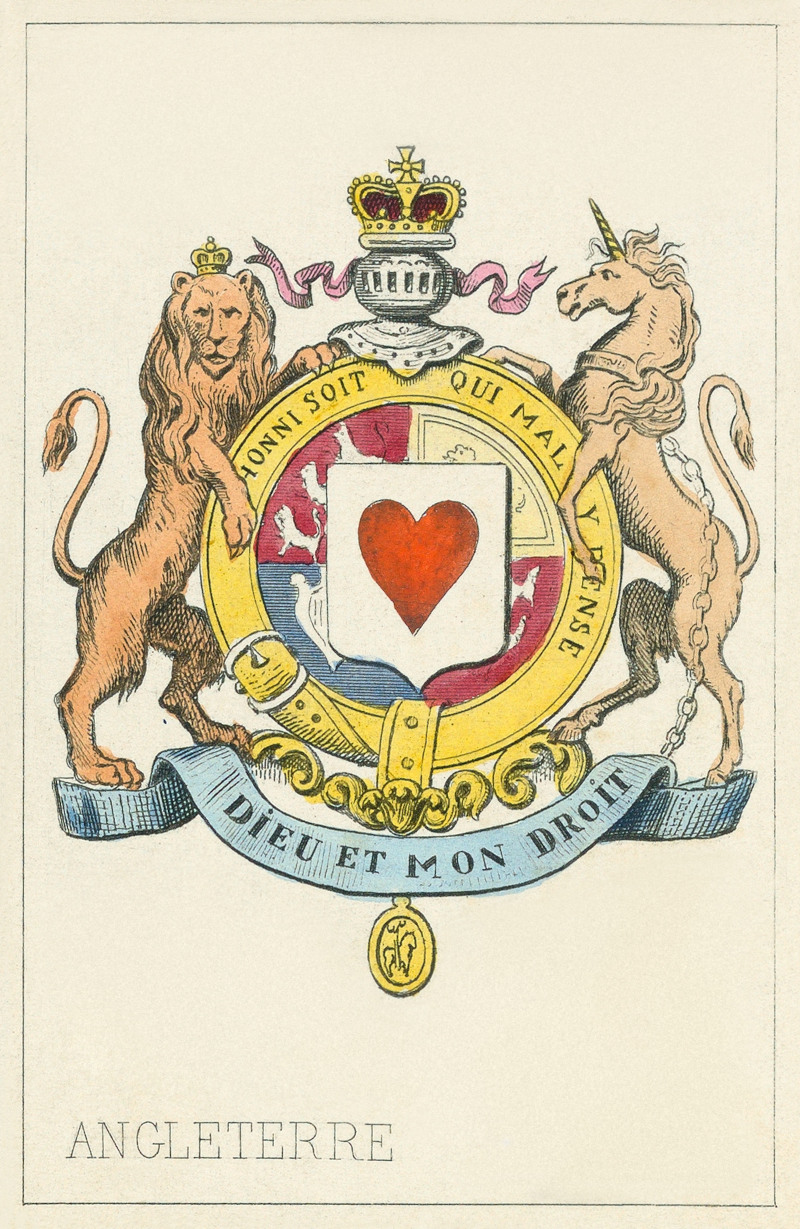 French Playing Cards (image provides by rawpixel as public domain, copyright-free)
French Playing Cards (image provides by rawpixel as public domain, copyright-free)
Medieval Lion Shield
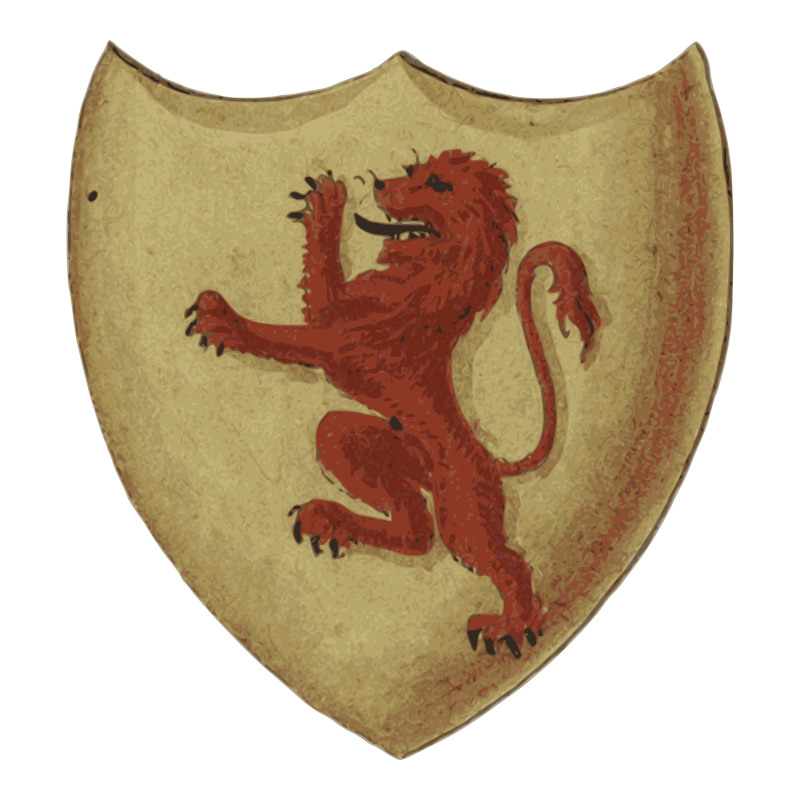 Medieval Lion Shield (image provides by rawpixel as public domain, copyright-free)
Medieval Lion Shield (image provides by rawpixel as public domain, copyright-free)
Introduction to Lion Art
Lions have played a prominent role within a number of cultures and their images have been used in a wide variety of ways. Symbolic meanings have been given to lions, whilst in other examples their aesthetic beauty has been utilised instead. The artistic styles in which their image has been delivered has also changed, from fairly primitive ways in the early ancient civilizations, up to highly polished sculptures and abstract art more recently.
Even across thousands of years, their connection to values of strength has remained constant, and their wild nature has kept our relationship to them relatively constant, whilst other animals have often become domesticated, such as cats or dogs, or become work animals, such as horses. The one biggest change with lion art is that in nations where they are not native, we have at least been able to see them in person, through the use of safaris and zoos, where as previously we would have had to rely on illustrations from artists.
Evolution of Lion Depictions Through History
Lions were used in ancient civilizations to represent power, protection, and divine authority, particularly within Egypt and Mesopotamia. They were most commonly found as carved elements, be it statues or architectural features. The Europeans in ancient Greece and Rome would then start to work with more accurate representations, and focused on their true anatomies, rather than idealized versions of the lions. This would not reach the precise work of the modern day until around the 18th century, as it was then that our knowledge of lions started to improve within the western world.
The animals would then be adapted to match the varying styles of European art after the Renaissance, such as the expressivenss found in the Romanticist era, as well as the abstract forms which followed in the 20th century. Eugene Delacroix was remembered for his drawings and paintings of lions, and he loved to portray the excitement and energy of wild animals fighting each other, or in conflict with humans and their horses. Outside of the western world, Africa and Asia have also featured them in a variety of ways.
Techniques and Styles in Lion Drawing
From the viewpoint of European art since the Renaissance, we will examine the different styles in which you might draw or paint your lions. First of all, line drawing techniques are particularly popular, especially with beginners. One can quickly construct a lion from a simple outline, using just a quick use of a pencil. This represents a great introduction to art, and an enjoyable method for sketching animals as a whole. For those looking to go further, one can learn from trained sketchers from art history to add more detail, such as with shading and texture.
When moving into painting, we can make use of abstract forms, with reduced detail but perhaps a clever use of color. There is also photo realism, where highly experienced artists will attempt to match the qualities of photography, but this would be considered highly advanced. Dali made use of animals within his Surrealist world, and digital art is also offering new opportunities, as artists construct complex illustrations over time using their tablet devices, and perhaps even their mobile phones.
Proportions and Anatomy
As with any figurative work, the study of anatomy is an important aspect in order to ensure accuracy. When working with lions, you must consider their head and facial features, torso and limbs, paws and claws as well as their muscular and bone structure. It is advisable to start with structure first, building up an image with simple shapes, perhaps in light touches of the pencil, before then adding smaller details later. This makes changes easier to implement and you should also take a step back at every stage to review your work from a distance.
It is well worth finding some photographs of lions from which to check different proportions, as animals clearly differ in many ways, and each species should be handled independently. When we consider victorian art, for example, you would often find exotic animals with elements from other creatures, as guess work was performed if the artist could not view the animal in person. With the spread of information today, as well as zoos and safari parks, this is thankfully less common.
Majestic Manes and Fur Texture
Much of the aura around lions, along with the symbolism which has been attached to them by a variety of civilizations, has occurred due to the presence of the mane. Depicting its texture and volume is an important part of lion art, and something that should be practiced. Of course, the manes will vary between male and female, as well as child lions, and these will give different atmospheres to your work.
Artists may vary light and dark tones, as well as the intensity of their lines in order to produce the right mane, whilst including a worn mane might give an image of creature who has lived a troubled life in the wild. Cartoon lions will tend to have elements of humanity within their appearance, as adapted forms to suit children's stories or an idealized version of how we imagine life in the wild to be.
Capturing the Essence: Anatomy and Features of Lions
Many studies have been published on lions to help artists understand their anatomies and improve the accuracy of their work. Each creature should be drawn without the bias of other animals, as their skeletal and muscular makeups are all different, even if there are similarities to be found. Many will place particular importance on the mane, because it is the most noticeable variation from other animals, but other, more subtle differences will be discovered once you take the time to really examine these creatures more closely.
For children carrying out simple sketches, it is, of course, more about fun and education. In this case, simply allowing them to express themselves is key, and they will pick out the main features themselves. Few critics would worry about mistakes with a child's work, and instead focus on its merits, such as the use of color in the right way, or placing it within the right environment of a jungle setting, illustrating a basic knowledge of lions.
Tools and Materials for Lion Drawing
The tools and materials for lion drawing are no different to any other animal art, with a choice of pencils, ink, pastels or digital tools being the most common options. Some today will draw on a tablet, and remove errors as they go, whilst others prefer the therapeutic nature of physically drawing something on spare pieces of paper. As you progress, you might use sketchbooks, in which all of your masterpieces can be kept safely, and you will also be able to review your improvements over time.
Textured paper can be good for extracting textures from your charcoal, but for children it is best to keep things as simple as possible - even a biro is fine for starting to learn the outlines of a lion and just practicing drawing. Many children benefit in their writing ability by drawing, which helps to build up strength in their fingers and wrists. It can also fire creativity in their minds, and potentially start to play with color as well.
Drawing easy lion for beginners - Step-by-Step Lion Drawing Tutorial
Start in as easy a manner as possible, focusing on outlines, with just a simple pencil before worrying about greater detail. Tracing can be an easy method of learning the curves of the lion, and children will often work in this manner. Also, don't worry about shading or depth until later on, a simple two-dimensional line drawing is perfectly adequate as you work out the proportions of their body. Many will construct the anatomy using squares and circles, before adding limbs and features of the head.
Famous Artists and Their Lion Artworks, including Paintings and Sculptures
Henry Edwin Landseer's lion sculptures in London are perhaps the most famous lion artworks to date, whilst Eugene Delacroix featured the animal a number of times within his Romanticist art. Franz Marc was famous for his animal paintings and took on lions and tigers within his expressive manner, whilst Henri Rousseau and Leonardo da Vinci also covered them within their own careers.
Lion Art in Different Cultures
As mentioned elsewhere in this article, cultures have handled lions in different ways within their art. Strength and authority symbolised their appearance within ancient art, whilst more recently they have been used to support conservation efforts, representing their popularity across the world, and our collective desire to protect their numbers into the future. African cultures have featured them regularly and have viewed them differently, because of their status as native animals, as opposed to exotic creatures in other regions of the world.
The Role of Lions in Modern Art
Conservation plays a major role in animal art of the 20th and 21st century. Posters will promote the protection of different animals, and typically their own image will be used to trigger our emotions. Some artsits will be more imaginative, perhaps resorting to sculptures or outdoor installations for the same purpose, whilst films and television also continue to spread the message about falling numbers of a number of species. Much of the symbolism around the animal continues today, and companies sometimes incorporate lions into their logos, hoping to connect its meanings with themselves.



